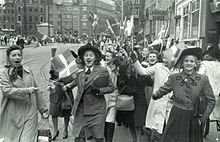click to dowload our latest edition
CLICK HERE TO SUBSCRIBE TO OUR NEWSLETTER


Published
6 years agoon
By
adminJULIE LEIBOWITZ
The fact that the mass and speedy evacuation took place with the assistance of many ordinary Danish and Swedish citizens, as well as one very connected German diplomat, makes it all the more extraordinary.
In just one week in late September 1943, the Danish Resistance Movement, with the assistance of ordinary Danish and Swedish citizens, managed to get 7 220 of Denmark’s 7 800 Jews and 680 non-Jewish family members to Sweden by sea.
They were ferried across the North Sea or Øresund (the strait that forms the Danish and Swedish border) in small fishing and sailing boats. One of the resistance groups was named the Elsinore Sewing Club, formed among friends in Elsinore, a town just 3.2km from Sweden. Its members combined their skills and resources to find vacant housing, fishing boats, and rationed gasoline to help Jewish refugees escape Denmark.
They primarily used small fishing boats, with occasional successes in using a mining ferry, a stolen larger boat, and a speedboat the club purchased with donations.
The last-minute rescue was made possible by the complicity of a German official, Ferdinand Duckwitz, a diplomat and attaché based in Copenhagen. On 28 September 28, Duckwitz leaked plans about the impending deportation of Denmark’s Jews to Hans Hedtoft, the chairman of the Danish Social Democratic Party. Hedtoft contacted the Danish resistance movement and the head of the Jewish community, CB Henriques, who in turn alerted acting Chief Rabbi, Dr Marcus Melchior.
At the early morning services, on 29 September, the day before Rosh Hashanah, Jews were warned by Rabbi Melchior of the planned German action. They were told to go into hiding immediately and to spread the word to all their Jewish friends and relatives.
Jews began to leave Copenhagen, where most of the almost 8 000 Jews in Denmark lived, and other cities, by train, car, and on foot. With the help of the Danish people, they found hiding places in homes, hospitals, and churches, before being spirited across the Øresund.
When the Nazis conducted the raid on 1 October, they found fewer than 300 people left. Of these, about 258 had just arrived and did not know about the evacuation, and 30 had been forgotten in an old-age home, according to the Swedish Ambassador to South Africa, Cecilia Julin.
Ultimately, about 500 Danish Jews were deported to the Theresienstadt ghetto in Czechoslovakia. Yet, of these Jews, all but 51 survived the Holocaust, largely because Danish officials pressured the Germans with concerns about the well-being of those who had been deported.
It is a story of heroics on both sides of the border, involving diplomats, policemen, and ordinary fisherman, often at great cost to the individuals involved in the underground, some of whom were tortured, executed, or sent to concentration camps for their efforts.
The daring rescue made Denmark famous as a nation that would go to extraordinary measures to protect its minority Jewish population, whom it considered to be Danish citizens. One of the reasons Denmark protected its Jews compared to other European countries was the fact that they had long been almost completely integrated into Danish society. Consequently, most Danes perceived the Nazis’ action against Denmark’s Jews as an affront to all Danes.
Another reason is the unique culture of the Danish people. According to a recent article in The Guardian, “The harming of Denmark’s Jews went against everything most Danes believed in, especially their concept of the rule of law. Even injustice needs a semblance of law. That is hard to find when the entire society denies the right of the stronger.”
A third reason was that as a “model protectorate” and agricultural power, Denmark was allowed to retain its government in spite of the fact that it had been occupied by Germany since 1940. This gave Danish leaders the flexibility to do the right thing.
Israeli President Reuven Rivlin travelled to Denmark last month to commemorate the 75th anniversary of the Danish rescue. He laid a wreath at the memorial to the Danish underground. There he said: “The determination with which the Jews of Denmark were saved moves us even today”, according to the Times of Israel.
Ordinary Danes and Swedes proved that widespread resistance to Nazi policies could save lives. It’s a lesson in being an “upstander” not a “bystander”, in doing everything we can to help others in need and stand up to bullies, Tali Nates, Founder and Executive Director of the Johannesburg Holocaust & Genocide Centre told the audience on Monday night at a screening of a film which documents the evacuation, titled The Straight Escape.
“Many Swedes were happy to be able to do something concrete,” Julin said, pointing out that Sweden’s history of neutrality during World War II was “not a very heroic position”.
“We just did… you just did. How could we have self-respect otherwise?” a member of the Swedish resistance asks in the film. He concludes with the words, “I hope we’ll have a world where decency will be the rule, not the exception.”
